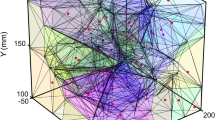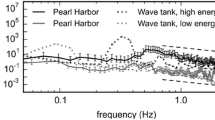Abstract
Diatoms are a group of photosynthetic microorganisms that play important roles in aquatic food webs and global biogeochemical cycles. They reside in the upper layer of oceans and lakes, and their interactions with the dissipation scales of turbulence govern a variety of processes, such as nutrient acquisition, prey–predator interactions, and aggregation. Interactions of cells with turbulence may also alter vertical motions and spatial distributions. However, observations of these interactions remain scarce because of the difficulty of generating ecologically relevant flows in the lab or tracking microscopic cells in the field. Here, we present an experimental system capable of measuring trajectories and spatial distributions of live diatom cells in turbulence. The small-volume turbulence tank uses stochastic forcing to restrict mean flow while producing homogeneous turbulence statistics at relatively high Reynolds number. Individual cell trajectories are tracked in three dimensions with a volumetric particle imager that uses the principle of defocused imaging combined with a double-pinhole aperture mask to obtain particle positions in three dimensions using a single camera. We conducted experiments at two different turbulence intensities and our results show that while root-mean-square velocities of diatoms are similar to those of tracer particles, their spatial distributions indicate enhanced clustering at the dissipation scales in comparison with tracer particles. This clustering behaviour is surprising both because diatom cells are characterised by a very low Stokes number and because clustering decreases when the turbulence intensity (and dissipation rate) increases. Several mechanisms could explain this result, including cell shape effects and active regulation of cell density in response to the ambient turbulence.
Graphic abstract












Similar content being viewed by others
References
Amato A, Dell’Aquila G, Musacchia F, Annunziata R, Ugarte A, Maillet N, Carbone A, Ribera d’Alcalà M, Sanges R, Iudicone D, Ferrante MI (2017) Marine diatoms change their gene expression profile when exposed to microscale turbulence under nutrient replete conditions. Sci Rep 7:3826
Armbrust EV (2009) The life of diatoms in the world’s oceans. Nature 459:185–192
Arrieta J, Jeanneret R, Roig P, Tuval I (2020) On the fate of sinking diatoms: the transport of active buoyancy-regulating cells in the ocean. Philos Trans R Soc A Math Phys Eng Sci 378:20190529
Ayres S (2017) Cell density (mass per unit volume) of diatom cells and chains in relation to their size, growth, and nutritional condition. Master of science thesis, University of Maine
Bellani G, Variano EA (2014) Homogeneity and isotropy in a laboratory turbulent flow. Exp Fluids 55:1646
Borgnino M, Arrieta J, Boffetta G, De Lillo F, Tuval I (2019) Turbulence induces clustering and segregation of non-motile, buoyancy-regulating phytoplankton. J R Soc Interface 16:20190324
Bowler C, Vardi A, Allen AE (2010) Oceanographic and biogeochemical insights from diatom genomes. Annu Rev Mar Sci 2:333–365
Buchhave P, George WK, Lumley JL (1979) The measurement of turbulence with the laser-doppler anemometer. Annu Rev Fluid Mech 11:443–503
Dell’Aquila G, Ferrante MI, Gherardi M, Lagomarsino MC, d’Alcalà MR, Iudicone D, Amato A (2017) Nutrient consumption and chain tuning in diatoms exposed to storm-like turbulence. Sci Rep 7:1828
Du Clos KT, Karp-Boss L, Villareal TA, Gemmell BJ (2019) Coscinodiscus wailesiimutes unsteady sinking in dark conditions. Biol Lett 15:20180816
Du Clos KT, Karp-Boss L, Gemmell BJ (2021) Diatoms rapidly alter sinking behavior in response to changing nutrient concentrations. Limnol Oceanogr 66:892–900
Efron B, Tibshirani RJ (1993) An introduction to the bootstrap. Chapman & Hall, London
Gemmell BJ, Oh G, Buskey EJ, Villareal TA (2016) Dynamic sinking behaviour in marine phytoplankton: rapid changes in buoyancy may aid in nutrient uptake. Proc R Soc B Biol Sci 283:20161126
Gillespie DT (1996) Exact numerical simulation of the Ornstein–Uhlenbeck process and its integral. Phys Rev E 54:2084–2091
Guadayol Ò, Peters F, Stiansen JE, Marrasé C, Lohrmann A (2009) Evaluation of oscillating grids and orbital shakers as means to generate isotropic and homogeneous small-scale turbulence in laboratory enclosures commonly used in plankton studies. Limnol Oceanogr Methods 7:287–303
Kolmogorov AN (1941a) The local structure of turbulence in incompressible viscous fluid for very large Reynolds numbers. Dokl Akad Nauk SSSR 30:299–303
Kolmogorov AN (1941b) Dissipation of energy in locally isotropic turbulence. Dokl Akad Nauk SSSR 32:16–18
Malik NA, Dracos T, Papantoniou DA (1993) Particle tracking velocimetry in three-dimensional flows. Exp Fluids 15:279–294
Malkiel E, Alquaddoomi O, Katz J (1999) Measurements of plankton distribution in the ocean using submersible holography. Meas Sci Technol 10:1142–1152
Malkiel E, Abras JN, Widder EA, Katz J (2006) On the spatial distribution and nearest neighbor distance between particles in the water column determined from in situ holographic measurements. J Plankton Res 28:149–170
Malviya S, Scalco E, Audic S, Vincent F, Veluchamy A, Poulain J, Wincker P, Iudicone D, de Vargas C, Bittner L, Zingone A, Bowler C (2016) Insights into global diatom distribution and diversity in the world’s ocean. Proc Natl Acad Sci USA 113:E1516–E1525
Maxey MR (1987) The gravitational settling of aerosol particles in homogeneous turbulence and random flow fields. J Fluid Mech 174:441–465
Mordant N, Crawford AM, Bodenschatz E (2004) Experimental Lagrangian acceleration probability density function measurement. Physica D Nonlinear Phenomena 193:245–251
Niazi Ardekani M, Sardina G, Brandt L, Karp-Boss L, Bearon RN, Variano EA (2017) Sedimentation of inertia-less prolate spheroids in homogenous isotropic turbulence with application to non-motile phytoplankton. J Fluid Mech 831:655–674
Ouellette NT, Xu H, Bodenschatz E (2006) A quantitative study of three-dimensional Lagrangian particle tracking algorithms. Exp Fluids 40:301–313
Ouellette NT, O’Malley PJJ, Gollub JP (2008) Transport of finite-sized particles in chaotic flow. Phys Rev Lett 101:174504
Pereira F, Gharib M (2002) Defocusing digital particle image velocimetry and the three-dimensional characterization of two-phase flows. Meas Sci Technol 13:683–694
Pérez-Alvarado A, Mydlarski L, Gaskin S (2016) Effect of the driving algorithm on the turbulence generated by a random jet array. Exp Fluids 57:20
Pope SB (2000) Turbulent flows. Cambridge University Press, Cambridge
Ragueneau O, Schultes S, Bidle K, Claquin P, Moriceau B (2006) Si and C interactions in the world ocean: importance of ecological processes and implications for the role of diatoms in the biological pump. Glob Biogeochem Cycles 20:GB4S02
Ruiz J, Macías D, Peters F (2004) Turbulence increases the average settling velocity of phytoplankton cells. Proc Natl Acad Sci USA 101:17720–17724
Salazar JPLC, de Jong J, Cao L, Woodward SH, Meng H, Collins LR (2008) Experimental and numerical investigation of inertial particle clustering in isotropic turbulence. J Fluid Mech 600:245–256
Tse IC, Variano EA (2013) Lagrangian measurement of fluid and particle motion using a field-deployable Volumetric Particle Imager (VoPI). Limnol Oceanogr Methods 11:225–238
Variano EA, Cowen EA (2008) A random-jet-stirred turbulence tank. J Fluid Mech 604:1–32
Willert CE, Gharib M (1992) Three-dimensional particle imaging with a single camera. Exp Fluids 12:353–358
Acknowledgements
The authors would like to acknowledge funding from the U.S. National Science Foundation (OCE-1334788 to Evan A. Variano and OCE-1334365 to Lee Karp-Boss and Peter Jumars). Additionally, we would like to extend our thanks to Peter Jumars for extensive discussions at the outset of this project and for providing comments on the manuscript, Laura Mazzaro for help with designing and constructing the prototype tank, and Morteza Gharib for fruitful conversations regarding the volumetric particle imager. We also acknowledge useful comments from anonymous reviewers.
Author information
Authors and Affiliations
Corresponding author
Ethics declarations
Conflict of interest
The authors declare that they have no conflict of interest.
Additional information
Publisher's Note
Springer Nature remains neutral with regard to jurisdictional claims in published maps and institutional affiliations.
Rights and permissions
About this article
Cite this article
Pujara, N., Du Clos, K.T., Ayres, S. et al. Measurements of trajectories and spatial distributions of diatoms (Coscinodiscus spp.) at dissipation scales of turbulence. Exp Fluids 62, 149 (2021). https://doi.org/10.1007/s00348-021-03240-5
Received:
Revised:
Accepted:
Published:
DOI: https://doi.org/10.1007/s00348-021-03240-5




